Acute, general. Later, geriatric
In 1871 a committee was set up in Beckenham to organise the building of a cottage hospital in Croydon Road. A local landowner and a member of the wealthy merchant banking family, Mr Richard Peter Hoare of the Kelsey Estate, paid for the hospital to be built at his own expense on his own land in Middle Barnett Field. The rental charged for the first five years was one shilling (5p).
The Beckenham Cottage Hospital, one of the first such hospitals in England, opened in 1872 with 4 beds. It was a traditional red brick building with high patterned wooden gables and decorative brickwork. It also contained public baths and a wash-house. The Hospital's staff consisted of a Matron and two Honorary Medical Officers. In-patients were charged 6d (2.5p) a day.In 1877 Peter Hoare died, and his executors increased the annual rent to £80, creating financial difficulties for the Hospital Committee, whose yearly budget was £370. However, funds were raised and the freehold purchased for £1,500.
Within ten years of opening the Hospital was too small (by this time it had 8 beds) and, in 1887, an extension - the Lea Wilson Ward - was added. There were then 13 beds.
Following a major fund-raising campaign, launched in 1897 to commemorate Queen Victoria's Diamond Jubilee, another extension was built. It contained an 8-bedded male ward on the ground floor and, above, an 8-bedded female ward and a children's ward with 4 cots. It was opened in May 1899 by Princess Henry of Battenberg and brought the total number of beds to 32.
In 1902 an X-ray apparatus was installed. As motor transport increased in the town, so did the number of road traffic accidents. In 1912 the Hospital treated 1,026 road casualties (it had received 285 the previous year).
During WW1 the Hospital was linked with the Naval Brigade Depot at Crystal Palace and with the Balgowan Road Schools in Beckenham, which had become an auxiliary military hospital run by a Voluntary Aid Detachment (VAD) under the control of the British Red Cross Society.
During the 1920s two new wards were added, but the Hospital was still too small for the increased population. Fund-raising activities began and, in 1924, another extension was added, containing the Percy Jones Ward for female patients and a male ward of the same size, both with 16 beds each. A Linen Guild was established in 1924 to provide or mend bed sheets, pillowcases and other items for the patients.
In 1929 the word 'Cottage' was dropped from the Hospital's name, and it became the Beckenham General Hospital.
In 1932 the Ruth Sutton Ward for children opened. Work began in 1938 on a new wing, which would provide a Nurses' Home, lecture facilities for nurse training, and rooms for private patients. It was to be named after Dr F.C. Trapnell, who had been the Honorary Medical Officer to the Hospital from 1914 (he retired in 1949). The building would also contain the boiler house, which would supply steam for the kitchen and for sterilization.
In July 1939, just before the outbreak of WW2, the Trapnell Wing was officially opened by the Duchess of Gloucester. It had cost £38,000 to build.
During WW2 many of the staff had enlisted in the Armed Forces, and those who remained had to work longer hours. In 1940 the Hospital became a Casualty Clearing Hospital, treating air-raid casualties. It had 135 beds, but the facilities were inadequate and the number of patients had more than doubled. The children's ward became a casualty reception ward (the children were moved to the staff dining room), while the maids' dining room was converted into an emergency operating theatre. Beckenham was badly bombed in April 1941 and the Hospital was inundated with casualties, with over 40 being admitted after one raid. The staff worked 13-hour shifts without breaks. Blast damage to the windows of the wards and corridors rendered the building colder than normal in the winter months. A Nurse Training School was established in 1941 and, because of the staff shortages caused by the war, nurses were not required to give up their jobs or their training course when they married. (The Training School later affiliated with Guy's Hospital and St John's Hospital in Lewisham.) In 1944, when the area was bombarded by flying bombs, the children were evacuated from the town.
After the war ended the local firemen redecorated the children's ward and raised money to sponsor a bed. As with many other voluntary hospitals, financial problems abounded. Many subscribers had moved away, the town's population was lower than before the war and the prospect of all hospitals becoming funded by the government's new National Health Service affected fund-raising schemes.
In 1946 the Hospital bought Kelsey Park Farm to use for staff accommodation.
In 1948 the Hospital joined the NHS under the control of the Bromley Group Hospital Management Committee, part of the South East Metropolitan Regional Health Authority. Under the NHS, voluntary organisations, such as the Linen Guild, were no longer needed and, indeed, were discouraged. The Nurse Training School became linked as well with the Children's Hospital in Sydenham.
By 1954 the Hospital had 100 beds.
In 1959 a new Out-Patients Department was officially opened by the Mayor of Beckenham, Kathleen Moore.
In 1969 a new male surgical ward opened, named after Mr Douglas Lindsay, consultant gynaecologist to the Hospital from 1919 to 1959. It had cost £50,000 and was intended to last ten years until the surgical unit moved to Bromley Hospital (in fact, it lasted almost 40 years). The Douglas Lindsay Ward was built on top of the Ruth Sutton Ward, which was then redecorated and became the female medical ward. Percy Jones Ward became the female surgical ward and George Stillwell Ward the male medical one.
In 1963 the Nurse Training School was regrouped with Bromley and Farnborough Hospitals. In 1973 the Accident and Emergency Department closed when a new centre opened at Bromley Hospital, although a Minor Injuries Unit remained, staffed by local GPs.
In 1974 an extension was built to accommodate geriatric patients, but 18 months later the patients were transferred elsewhere and part of the wing was left vacant.
By 1977 the Hospital had become an acute general hospital with 116 beds, but rumours about surgery being withdrawn and possible closure began to arise. A campaign, initiated by Ian Higton, one of the consultant surgeons, to save the Hospital was successfully taken up by the media. A petition of over 22,000 signatures was presented to Parliament by the local MP, Sir Philip Goodhart. The Hospital survived, but surgery ceased in 1986 as an attempt by the Area Health Authority to save money. It then became the Beckenham Hospital, a geriatric hospital with 84 beds, providing out-patient clinics, services for the elderly and a Minor Injuries Unit.
The Hospital closed in 2005.
Present status (August 2010)
Most of the original buildings have been demolished.
Work began on redevelopment of the site in 2005. The project was built in two phases, at the cost of around £26m, and was completed in 2009. Funded by the Local Improvement Finance Trust (LIFT), it was the largest such project in the country.
The community healthcare facility owned by Bromley Primary Care Trust has been named the Beckenham Beacon. No longer a hospital, the health 'one-stop shop' (polyclinic) contains an Urgent Care Centre, out-patient clinics, GP surgeries, a dental surgery, a community health care unit, an X-ray Department, a phlebotomy service and a pharmacy.
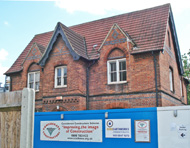
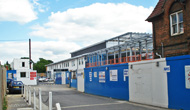
An original building on the south corner has survived (left). Looking along Croydon Road from the south (right).
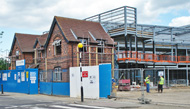

The original building on the north corner has also survived (left) and is being integrated with the new polyclinic (right).
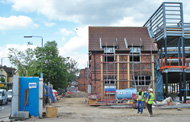
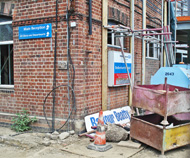
The northern corner building (left) with the entrance to the former Beckenham Hospital (right).
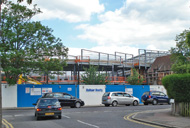
The building site, as seen from Cedars Road.

The Beckenham Beacon, as seen from across the construction site.

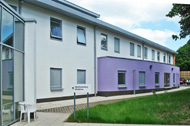
The entrance to the Beckenham Beacon (left) and the newly finished part of the building (right).
(Author unstated) 1899 (Untitled) Nursing Record and Hospital World 22, 420.
Emrys-Roberts M 1991 The Cottage Hospitals 1859-1990. Motcombe, Tern Publications.
www.bromley.nhs.uk
www.bromleyhospitals.nhs.uk
www.edithsstreets.blogspot.com
www.francisfrith.com
www.general-demolition.co.uk
www.geograph.org.uk
www.greenwichpct.nhs.uk
www.hospitalartstudio.co.uk (1)
www.hospitalartstudio.co.uk (2)
Return to home page